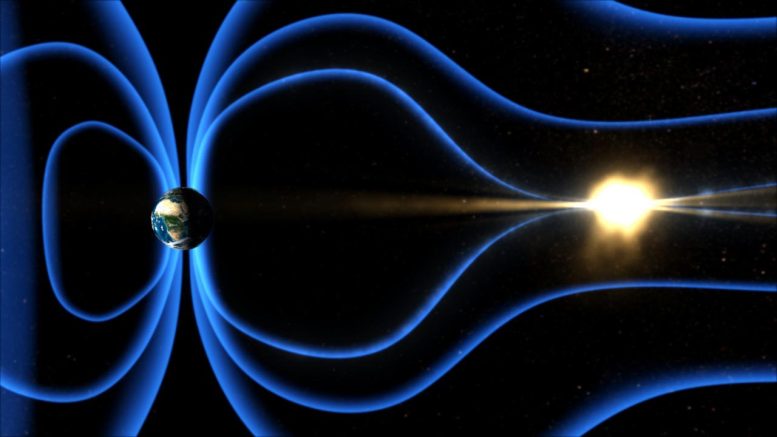Investigating Unusual Substorms in Earth's Magnetosphere

The image shows reconnection of magnetic field lines around Earth in the magnetotail, an early indicator of a substorm. A Southwest Research Institute project in progress, funded internally, is investigating the nature of substorms by using a 2017 event as a case study in which reconnection seemed to occur in the absence of a substorm. The picture is credited to NASA/Goddard Space Flight Center-Conceptual Image Lab.
With data from NASA’s Magnetospheric Multiscale (MMS) mission, the SwRI is studying uncommon substorm events in Earth's magnetotail aiming to get a better understanding of magnetic reconnection and its impact on the global magnetosphere.
The Southwest Research Institute (SwRI) is currently examining an atypical occurrence in the magnetotail of Earth, the Sun-ward elongated projection of the Earth's magnetosphere. The SwRI scientists are scrutinizing the nature of substorms, temporary disruptions in the magnetotail that let out energy and typically result in aurorae, by using data acquired from NASA’s MMS mission.
From their launch in 2015, the MMS spacecraft has been examining the magnetopause, the demarcation between the magnetosphere and the surrounding plasma, to detect signs of magnetic reconnection. Such reconnection happens when magnetic field lines of force converge, break, and reconnect, rapidly changing magnetic energy to heat and kinetic energy. In 2017, MMS detected signs of magnetic reconnection in the magnetotail, but without the usual concurrent indicators of a substorm, like intense electric currents and magnetic field disturbances.
The image illustrates the four MMS spacecraft orbiting in Earth’s magnetic field. The image credit goes to NASA.
SwRI’s Dr. Andy Marshall, a postdoctoral researcher, said their aim is to comprehend how local physics recorded by MMS influences the entire global magnetosphere. He explained their objective to enhance understanding of the causes of a substorm and the connection between substorms and reconnection by juxtaposing that occurrence with more typical substorms.
In the ongoing year-long project, SwRI will match in situ MMS recordings of reconnection impacting local fields and particles with global magnetosphere reconstructions. The reconstructions are made by the Community Coordinated Modeling Center at NASA’s Goddard Space Flight Center using the University of Michigan’s Space Weather Modeling Framework.
“There is a chance that there are notable differences between the worldwide magnetotail convection patterns for substorms and tail reconnection events without substorms,” stated Marshall. “We haven’t studied the motion of the magnetic field lines at a worldwide scale, hence, it is possible that the anomalous substorm observed was a very localized incident which MMS happened to record. If this isn’t the case, it could significantly alter our comprehension of the connection between tail-side reconnection and substorms.”
MMS is the fourth mission of NASA’s Solar Terrestrial Probes Program. The four MMS spacecraft were constructed, integrated, and tested by the Goddard Space Flight Center, which is also accountable for overall mission management and operations. The chief investigator for the MMS instrument is based in San Antonio at SwRI. Science operations planning and instrument command are performed at the MMS Science Operations Center housed at the University of Colorado’s Laboratory for Atmospheric and Space Physics located in Boulder.




